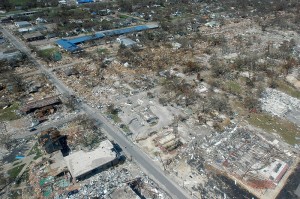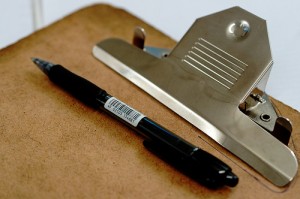
Hurricane Katrina caused extensive damage along the Gulf Coast in 2005. Having a disaster plan can keep your business running in a crisis.
Hurricane season is right around the corner and the National Weather Service predicts that this will be a busy year. Other areas of the country worry about tornadoes and floods. Add in avalanches, wildfires, and mudslides. It seems that no area is safe from disaster. And since you don’t always know when or where disaster will strike, both businesses and families should be prepared.
It’s been over four years since Hurricane Sandy ravaged the East Coast. According to one study, the storm had a devastating impact on many small and medium-sized businesses.How prepared is your business?
A Disaster Caused By Giant Lizards?
Most businesses have a disaster recovery plan somewhere. I bet if everyone in your office dug through all the dusty notebooks on their shelves, someone might even find one. When was the last time you reviewed it, as a management team or with the entire staff? Is it still relevant? Is it customized to your particular location, or is it a cookie-cutter printout you got to fulfill a mandate from somewhere?
In the acclaimed 1970’s sitcom, WKRP radio newsman, Les Nessman, thought he was reporting the biggest story of the year when he made this startling announcement: “Monster Lizard Ravages East Coast!”
It turned out to be one of the most famous typos of all time.
In a later episode, with tornadoes threatening the city of Cincinnati, the station’s program manager told Les to get on the air and read from the station’s disaster plan, one that was uniquely suited to the Cold War, not a cold front. “Just insert the word ‘tornado’ where you need to,” Andy told Les. This led to the hilarious clip of the station’s news director warning about “armies of godless tornadoes” invading the River City.
That’s a lesson for every business: keep your disaster plan up to date!
Develop A Business Disaster Plan A good disaster plan starts with these two steps: make a plan and communicate it. But let’s dig a little deeper.
Make a Plan: If you don’t have a disaster plan or if it’s time to update the plan, ask yourself these questions:
- Does your staff know where to go in your building in an emergency?
- How will you communicate that information to customers who are in your building at that time?
- Is your on-site shelter area adequately equipped with items such as drinking water, non-perishable food items, flashlights, batteries, first-aid kits and blankets?
- Whose responsibility is it to see that these items are stocked and in working order?
- How do you hold them accountable?
- Does your business have a generator in the event of a power outage?
- How many people know how to operate the generator?
After the immediate threat to life has passed, you need a plan to communicate with employees and customers.
- What’s your contingency plan if you lose telephone or Internet service?
- If you are in the path of a hurricane, or if you building is uninhabitable, do you have an evacuation plan?
- Will your staff meet at an alternate location, or will staff members work remotely?
- Does everyone on staff know how to contact each other if working remotely (cell phone numbers, home phone numbers, personal email addresses, etc.)?
Communicate the Plan: Having a plan is critical. But you also have to communicate the plan if you want it carried out. And don’t think that just printing up a bunch of notebooks will do it, either.
Have annual meetings about the disaster plan. Consider having a small committee that reviews the plan each year and revises it as needed. Definitely have a full staff meeting to communicate the details of the plan. Staff members need to feel confident about their role during the disaster, and the company’s expectations. For example:
- Are staff members who are off work at the time of the disaster expected to call in?
- If working remotely, how often am I expected to check in with my supervisor?
Communicate to your customers as well. You probably don’t need signs and posters around the building all the time, but consider posting disaster procedures when severe weather is possible. Also, know who on your team will manage your website and social media channels. Those will be critical avenues for two-way communication.
Your telephone on-hold messages are a critical component of all your communications, and they can play a key role during a disaster, too.Many customers, vendors and partners will call to check on your business if they hear of a disaster in your area. If things are not business as usual, don’t let your on-hold messages suggest otherwise.
After recent disasters, severe weather is a threat that people take seriously. It’s unnerving to realize that, within a couple of hours, or even minutes, everything familiar can be destroyed around you. A good disaster plan gives your employees the tools and training to keep their heads during a crisis and protect lives and property.
Business & Finance Articles on Business 2 Community(67)
Report Post






